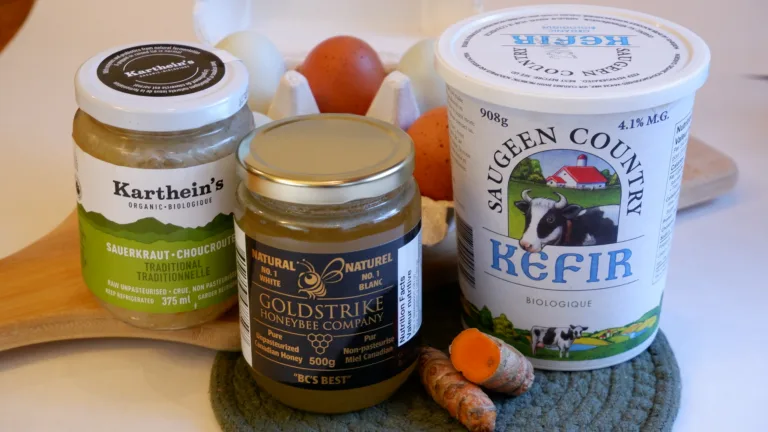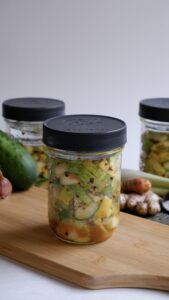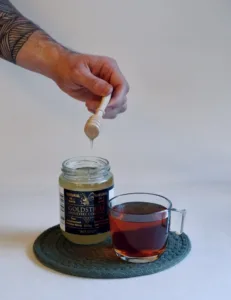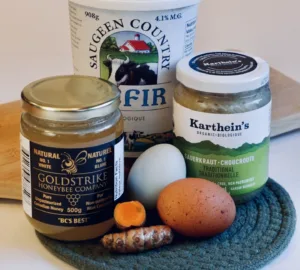
It should come as no surprise that there is no single “superfood” that is the secret ingredient to bring you perfect health and happiness. Like a healthy ecosystem, diversity is key along with avoiding artificial substitutes. To help get you started on your journey to a harmonious state of living, we have rounded up five great foods you can add to a host of different meals to get a healthy boost of probiotics, antioxidants, and other key nutrients.

Eggs are incredibly nutrient-dense, they are filled with a variety of vitamins and minerals, protein and fat. Due to this many people often refer to them as the perfect multivitamin. They contain high amounts of vitamins B12 (needed to form red blood cells), B6 (beneficial for the immune system and nervous system) and B2 (helps in the breakdown of proteins, fats and carbohydrates). They also contain selenium, which is important for thyroid health. Boosting thyroid health is particularly beneficial as it controls a lot of processes and metabolic functions throughout the body such as digestive processes and muscle development. Furthermore, your body doesn’t make selenium so it’s rather important to get adequate intake from our food. It’s important to note that low selenium is becoming increasingly more common even among healthy adults due to the deteriorating health of our soils. When the soil in which we grow our crops becomes depleted, our foods are less nutrient-rich. Adding eggs to your diet may be one way to mitigate this. Another important nutrient found in eggs is zinc, which is important for healthy immune function and testosterone regulation, so high-performing athletes may want to up their intake of eggs too (PMID: 36577241).

It’s understandable that many people, especially ones who follow a vegan diet, may be reluctant to add eggs to their diet due to ethical reasons. However, if we as a society become a little bit more mindful of where we buy our eggs we could dramatically increase the general welfare of chickens. Sourcing from local farms, which ethically raise their chickens, is also important not just for the welfare of the animals but for environmental reasons. Large-scale egg farms release large amounts of ammonia and other waste products into the surrounding area which can make its way into rivers, lakes, ponds and farmland. Small-scale pasture farms allow their chickens to roam free during the day and they have large amounts of free space and outdoor time to forage and explore and be chickens! When allowed to forage chickens will have a varied diet of bugs, worms and vegetation. Furthermore, they often supplement their chickens’ diet with non-GMO and organic grain. Think of how good you feel when you’re left to be free and to roam outdoors. Pasture-raised chickens or chickens raised on a high omega-3 diet produce eggs that contain a lot more omega-3 which is known to reduce inflammation and be beneficial for eye health and brain function. So great for overall health and well-being.
Eggs are a great source of complete protein. Two whole eggs are around 12 grams of protein. They can be added to most dishes. Great for breakfast on sprouted grain bagels or a sweet potato hash. Added to the top of burgers and sandwiches, poached in soups like ramen or shakshuka, and added to Asian-inspired rice or noodle dishes.
Both sauerkraut and kimchi are fermented foods created by pickling fresh cabbage leaves (along with other vegetables) using lactobacillus, which is a type of lactic acid bacteria. These foods are free from gluten and are rich sources of gut-friendly probiotics. These foods are a great way to add necessary friendly bacteria to your microbiome. (PMID: 35406140)

The lower part of the small intestine and colon contain many microbes that live in harmony with us. They are often referred to as symbiotic since we need them and they need us. With a diet lacking in food that the good bacteria like to eat (such as fibre) and high amounts of food that the bad bacteria like to eat (sugar, processed food), an imbalance can occur. Gut health has been strongly associated with immune health.
When more harmful bacteria overcome the good, bodily systems may not function properly. Alcohol can kill off or starve good microbes, as can processed foods and continued use of certain medications, so reduction in consumption of these can help bring about balance, so sometimes it’s not just about adding things but taking things away. Consequences of an overgrowth of harmful gut bacteria can be stomach cramps relieved momentarily after bowel movements, and sugar and alcohol cravings (the bacteria in our gut are inherently connected to your brains so in a sense they can direct our choices towards certain foods that they prefer), hormonal imbalances, feeling overwhelmingly anxious and stressed (this may be due to the fact that the bad bacteria release toxic gasses during their digestion process which can cross the blood-brain barrier and in turn may transfer into the central nervous system – PMID: 33061482). Consuming more probiotics, such as kimchi and sauerkraut, which contain a large amount of friendly bacteria, can help re-populate your intestinal system and will potentially relieve many of these symptoms.

These products are vegetable-based and often contain spices and herbs so you’re also getting a good dose of nutrients from those too. Garlic for example is known to be antibacterial and antiviral. Kimchi a traditional South Korean staple is often fermented with chillies and ginger which contain antioxidant properties.
There are many great brands found in local supermarkets, and many local farmers markets often have their own versions of fermented products too. You can even easily make your own at home. It’s quick to make prepare and fermentation only takes around two weeks. Look out for our recipes on this coming soon.
Kimchi or sauerkraut can be added to tons of dishes to add a nice boost of flavour and probiotics. Put on top of omelettes, steaks, noodle dishes, or sandwiches, and the leftover juice can be added to dressings and sauces – some people even shoot it back!

Turmeric has been used for thousands of years for its medicinal qualities and is often described as a functional food (PMID: 33396698). Various studies suggest it has anti-inflammatory properties so it makes it incredibly valuable for people who exercise frequently. One study found that ‘participants supplemented with curcumin [the bioactive substance in turmeric] displayed reduced inflammation and oxidative stress, decreased pain and muscle damage, superior recovery and muscle performance’ (PMID: 32282223). Inflammation after injury or intense physical activity is a necessary component of the healing process, and small amounts can be beneficial, but if inflammation continues over long periods and becomes chronic, then it can be detrimental to health. When your body detects a virus or injury it activates your immune system and sends out inflammatory cells and cytokines. These cells then begin an inflammatory response to trap bacteria and other potentially threatening substances or they begin their process of healing damaged tissue. The results are pain, swelling, heat and redness. Inflammation can also affect systems you can’t see or feel.
Acute inflammation is inflammation that acts as an immediate response and helps the body heal. Chronic inflammation happens when your body continues to send out inflammatory cells after the healing process is complete or if your system is regularly exposed to environmental toxins, has an autoimmunity issue or has untreated acute inflammation such as an infection or injury that won’t heal. The process of chronic inflammation has been shown to play a major role in most chronic illnesses, including neurodegenerative, cardiovascular, pulmonary, metabolic, autoimmune and neoplastic diseases (PMID: 18662800). Foods with anti-inflammatory properties may help in reducing these and can also support your body during its acute inflammation stage.
Curcumin has been shown in research to manage oxidative stress as it is high in phytonutrients that can help protect the body from free radicals (pollution, toxins from food); oxidative stress is closely related to inflammatory processes in the body. Curcumin is said to exert anti-inflammatory effects by regulating inflammatory signalling pathways and inhibiting the production of inflammatory mediators (PMID: 34754179).
Turmeric can be added to a myriad of foods such as curry dishes, and spicy breakfast sweet potato hash, and it can be added to teas and smoothies too. Try grated ginger, turmeric, cinnamon and rooibos tea leaves in a strainer, teapot, or tea ball for an uncaffeinated, nourishing anti-inflammatory hot drink.
For thousands of years, cultures around the world have been using domesticated animals as sources of key micro and macronutrients (PMID: 32277831). Milk and fermented milk products are known to be loaded with amino acids, calcium and vitamin B12. Once fermented they become loaded with gut-friendly bacteria. Consuming dairy products might not be for everyone as it may not align with your particular way of eating for ethical or allergy reasons. There are a few great vegan alternatives such as fermented coconut yogurt which can offer similar nutritional value and beneficial bacteria, however, be mindful of the sugar content often found in these products. When sourcing dairy products it’s important to realise that not all dairy is created equally. Animal welfare is of the utmost importance so aim to source from local, sustainable, organic farmers who do not use hormones on their animals. You want to find sources that are grass-fed and free to roam outdoors. Keywords on labels to look for are ‘pasture-raised’, ‘grass-fed’, ‘organic’ or ‘heritage’. In her book ‘Farmacology: Total Health from the Ground Up’, Daphne Miller MD visits a farm where the owner refuses to inject his cows with medicine and instead lets them forge and build their immunity through natural processes. Upon viewing this she writes that his methods have resulted in healthy, happy cows who very rarely suffer from any illness and produce high quality nutrient dense milk. More commercial dairy farms often inject their cows with steroids, hormones and spray their hides with antibacterials while also feeding them foods sprayed with herbicides and pesticides. Often dairy allergies can be mistaken for over consumption of dairy products that may be filled with such hormones (PMID: 26258087). Ingesting hormone-laden dairy may lead to acne, poor digestion, digestive upset and hormonal imbalance (PMID: 19085072).

For those that are lactose intolerant, some suggest that Kefir may be suitable dairy source. Lactose intolerance occurs when the body lacks the ability to naturally produce lactase. Lactase is the enzyme responsible for breaking down lactose into digestible forms—galactose and glucose. During the fermentation of kefir, the bacteria release lactase, facilitating the breakdown of lactose, with glucose and galactose serving as substrates for fermentation. This stage in the fermentation process results in the production of acetaldehyde and lactic acid, effectively reducing the pH of the milk. Notably, this bacterial fermentation process has been demonstrated to decrease the presence of lactose.
Fermented dairy can be added to many aspect of your meals. A creamy topping for your morning oatmeal (add on top after the oats have cooled slightly; adding when it’s too hot may destroy the beneficial bacteria). Try making dips or sauces for wraps, burgers and sandwiches by mixing with lemon or lime, a pinch of salt and spices of your choice. Or try mixing with your favourite protein powder, then top with berries, nuts such as almonds, and seeds such as pumpkin to make a smoothie bowl. One half cup serving is packed full of bacteria and nutrients, so you don’t need loads. A little goes a long way.
Honey is one of natures true wonder foods. It’s packed with antimicrobial, antioxidant and anti-inflammatory properties (PMID: 28539734). It’s also important to note that honey is said to be rich in compounds called polyphenols (as the honey is made from plant material gathered by bees) which are known to help prevent oxidative stress. Darker honeys are believed to have more important bioactive plant compounds and phenolic acids, so they may be even more beneficial. Look for ‘unpasteurized’ as this means the honey has been minimally processed and the active compounds are still there.

Honey is a natural source of sugar and may offer some slight benefits over blood sugar regulation than other processed sugars such as cane. Some research has found that honey may increase the hormone adiponectin (which is responsible for reducing inflammation and improving blood sugar regulation) but having said that it should still be consumed in moderation. One table spoon still contains about 17 grams of carbs and is quickly absorbed into the blood stream. For this reason it can be a great fuel for long distance runs or long days in the mountains. Try mixing into peanut or almond butter and adding dark chocolate, or stirring into low fat yoghurt (fat slows absorption) and a protein powder of choice as a quick easy and tasty pre-workout formula.
Honey’s antibacterial properties have been utilised for thousands of years. Evidence points to its use as a medicine, both topical and oral, and as a preservative during the height of both the Roman and Egyptian empires. Archaeologist have even found honey that is still edible after being left in tombs for thousands of years attesting to power of its preserving abilities.
Research has shown that it has a high potency of antibacterial properties. Hydrogen peroxide is known as an important oxidising and sanitising agent and it is produced enzymatically in honey, an important feature of its antibacterial activity (PMID: 31281362) It is for this reason why many think it is a useful remedy to be used during bacterial infections such as strep throat and viral infections such as the common cold.
When purchasing honey try to support local bee keepers and farms. Much of the honey that comes from outside of Canada can often be diluted with syrups and may be blended with a variety of other honey products with varying degrees of quality. The welfare of the bees should also be at the forefront of the producers’ priorities. Small scale bee keepers will treat their bees with care and respect and will manage a hive so it is less likely to contract diseases or be attacked by predators. They will also ensure that the bees are left with enough honey to survive the winter, only taking what is extra, and they encourage the bees to make more honey than they need by ensuring they have ample pollen supplies. Buying local honey is also said to to alleviate seasonal allergies to pollen. The theory goes that by ingesting small amounts of local pollen over time a person may become less sensitive to it, however this is yet to be fully verified in studies. To counter this theory immunologists mention that often times the allergies one suffers during high pollen season is from grasses and tress and often not from flowers. Flowers tend to be the main source of pollen for bees as flowers have evolved to entice them with their array of colours and shapes. However what is interesting to note is that different flowers and thus different pollens from different areas will change the taste, colour, antibacterial properties and nutrient density of your honey.
Honey can be added to almost all foods that require sweetness. Try it in salad dressings with tahini, nutritional yeast, garlic, and lemon juice. Or add it to your post workout smoothie to get a healthy dose of quick release carbs to help refuel your muscle glycogen levels. Use it to sweeten your tea, but wait until it’s cool enough enough to drink then add it; adding to boiling water will kill the beneficial enzymes and bacteria.

You may have noticed a common trend that links all the foods in this list. Minimally processed, around pre agricultural and industrial stages, and wholesome real ingredients. These foods and many more are ones that we could cultivate using minimal processing. Foods that we have eaten for thousands of years and existed before the agricultural revolution seem to posses the most beneficial bacteria, antioxidants and nutrients as they are whole foods in their complete form, nothing is artificially added or taken away. It is also becoming increasingly obvious that the rise in pre-packaged, nutrient void food products may be to blame for the increase in diseases we see in modern society. These are often very calories dense and we can have an extreme likeliness to over eat them resulting in weight gain, they can also have detrimental effects on the endocrine and digestive systems. The foods in these lists are great easy ways to add nutrients and other beneficial properties to your diet, especially useful if you have a tendency to reach for less nutrient dense foods.
Sign up for our newsletter to receive the latest articles to guide your journey to a harmonious mind, body and spirit.
Follow along with us @sunadaliving